Artists at Work: Roksana Pirouzmand
by Michael Ned Holte
I met Roksana Pirouzmand during a Thursday gallery night at CalArts, introduced to me by a fellow Iranian who was currently attending the school. Roksana was curious about CalArts, so I invited her to attend my art history class on Monday nights. She did, with quiet regularity, and within a year she was enrolled in our BFA program. Soon I was surprised to find this shy, polite student had installed a giant swing in the vast Main Gallery and was performing for three hours while Skyping with her family in Yazd, Iran. Everything that followed had a similar go-for-broke ambition and some bewildering element of surprise: a crocheted birth canal, a pair of leg holes buried in the lawn, a dress that became a doorway, a clay mask that became a surreal interface for communication. After pursuing her MFA at UCLA, Roksana has continued to astound, with memorable showings at Los Angeles galleries such as Murmurs and Del Vaz Projects (both 2022) and in “Made in L.A. 2023: Acts of Living” at the Hammer Museum. We met in her Van Nuys studio in summer 2024 over tea and dates while she was preparing for solo exhibitions at Francois Ghebaly, New York and Spurs Gallery, Beijing.
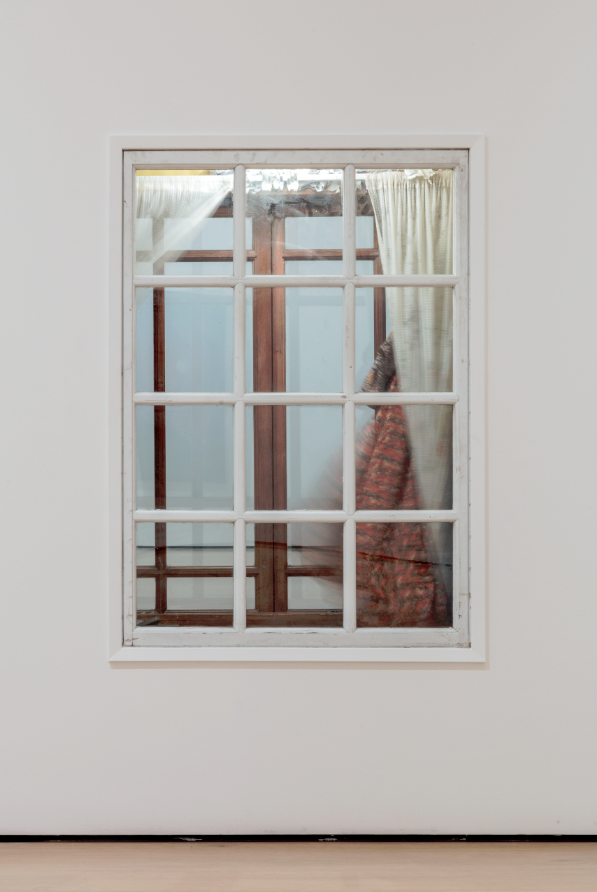
Roksana Pirouzmand, Between two windows, 2023. Installation view, Made in L.A. 2023: Acts of Living, Hammer Museum, Los Angeles, October 1–December 31, 2023.
Michael Ned Holte: I want to start with your appearance in “Made in L.A.” at the Hammer. In your case, it was a very literal appearance. You performed every Saturday in an installation titled Between two windows in which you were sandwiched between two domestic windows, each representing your two homes in Los Angeles and in Iran. You were on view to the audience while also subjecting yourself to a high-velocity fan blowing photos around the compressed space. What was that experience like over the three months of the exhibition?
Roksana Pirouzmand: I would say it gradually changed—it turned into more of a ritual that I was doing every Saturday. This could be very sentimental, but they were all family photos, and at some points I would land on a photo that was rotating and feel really far from home. It was a personal experience, and I realize many people didn’t know what the photos were and didn’t have that same connection with them. We started making it three weeks before the show, so I couldn’t experience it myself until a few days before the opening when I actually could stand there and see what it was.
MNH: There’s an interesting question of whether one practices or how one prepares for doing a performance like that, which requires a certain amount of endurance, and it’s not the first time you’ve done something that has intense physical or temporal demands. How do you prepare for something like that?
RP: Yeah, my performances are not something that I practice or rehearse beforehand. They’re usually very mundane, single, simple actions and I just have an image in my head of what it’s going to be like. The first performance is always the most exciting, and because the viewer is also there for it, I feel like it becomes complete. With Between two windows I became, not an object, but equal to the photos that were floating. In a way, the photos and the window and I had the same presence.
MNH: One of the fascinating things about that particular performance/installation is that you remain still while the photographs are moving around the space, you are almost like a sculpture.
RP: Yes, exactly. I went for stoicism, not too many emotions, and with the objects more active than I was. I tried to bring the visual language into a poetic realm.
MNH: It was very poetic. I’m also interested in your relationship to an audience in your performances, because in the case of the Hammer installation, the viewers were in your periphery. I’m sure you were aware of their presence, but maybe not of them individually.
RP: I always think about the viewer, and I think it’s definitely a part of the context of the work. When I was performing I was aware of when people were around me. I was also aware that these were family photos I was using and usually, obviously, they’re very private and you don’t showcase them to strangers. Sometimes someone would stand on the other side of the window and actually be looking at the photos just as I was looking at them […] When I was thinking about the idea for the performance I was definitely aware that there was an aspect of revealing something very private. It’s a vulnerable situation, especially if you are from another country and don’t know how things will be read. I think there would be a difference in how an Iranian friend sees those photos and what their take would be.
MNH: They would understand the cultural specificity.
RP: Exactly.
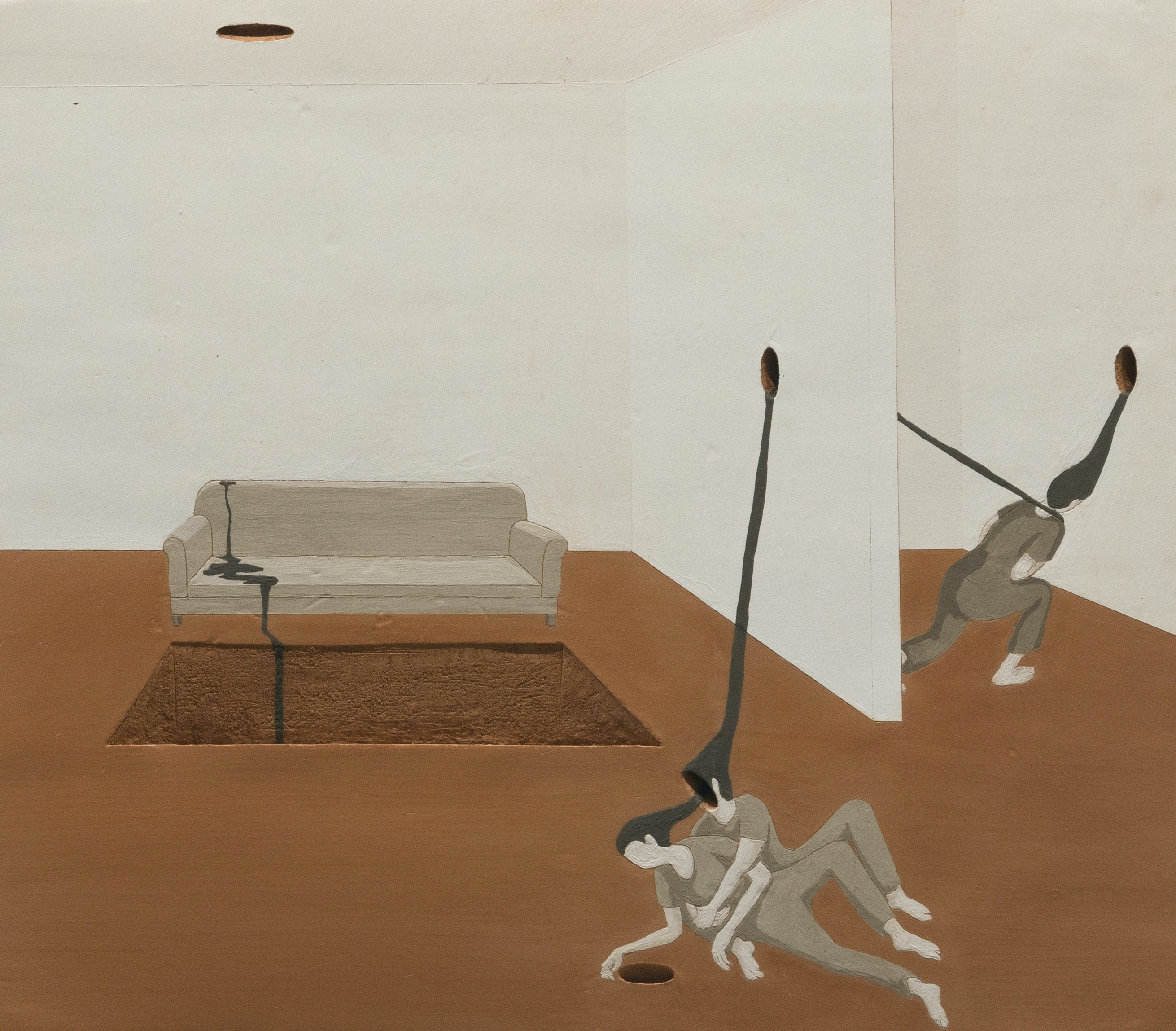
Roksana Pirouzmand, detail from they last forever series, 2021. they last forever, Grand Central Art Center, Santa Ana, September 4 – December 5, 2021.
MNH: So you were born in Yazd, Iran in 1990 and moved to L.A. when you were 21. You already had a performance practice in Iran. Can you tell me about that?
RP: I went to art high school, and you have to decide what your major is when you’re in high school. I was very lucky—I went to this school at a very good time. There was a teacher there who was very young and enthusiastic and had just graduated from Tehran University. He was bringing us updated things about what was happening out in the world. I had no idea what performance art was, or even what modern art was. When I first saw Kandinsky I was like, “Oh my god, this is amazing! Someone can paint just squares and rectangles!”
So, I was very excited. That was my first exposure to abstract art and then soon I realized you can actually use your body as your work and an action could be an art form. After graduating from high school with seven other friends, we started this collective where we would do performance actions. We would get together almost every day and make paintings. Whenever there was an opportunity, we would think about performance and how we could do it in a public space.
That’s when I became really excited about performance because it was so quick—you could do it and leave no trace behind, only in the eye of the viewer. It felt very liberating in a way, especially in that context, in a city like Yazd. I think now it has changed, but at the time it was a very religious city. Women could do the smallest action and be told that they were breaking the rules, so doing these performances I felt very brave. For one performance I painted in a pond at the university.1We knew if we explained what we were doing, they would not give us permission. So, we did not explain and we just did it and that was it. Whoever saw it, saw it, and we’d have some video documentation of it.
I think those performances I did in Iran felt the most powerful to me as an experience of myself. When I came here, especially in the beginning, I was lost within the context. I did not understand what works here, what images could have an impact on a viewer. I really didn’t know—and I still feel like I don’t know exactly. I feel like I have a better sense, but I will never know one hundred percent. When you grow up in a place, you have a better sense of what are the things that you can poke at.
MNH: I’m struck and curious about the potential risk of what you were doing, too. So much of what makes art political is the context in which it is made. When I think about the work you were making in Yazd, having only seen a couple examples on your website, I immediately sense that risk because of the cultural context in which it was being made and perceive that maybe the politics of your work are usually more implicit than explicit.
RP: Definitely. I confess that even when I was doing it in Iran, I was not thinking about the politics. Now it could be read in other layers, but when I was painting in the pond, for example, it was just like, “Look, I’m painting!” Also we were in a university, so I was thinking more about the institutional context. But Iran has changed within the past 12 or 13 years and things have become more sensitive. At this point, do you do anything and it’s not political?
MNH: So much of your work that you’ve made since moving here has been about a relationship between whatever this idea of “home” is and what that formative idea of home in Yazd is. I still remember so distinctly that performance you made in your first year at CalArts, with the swing in the Main Gallery.2It’s rare for a first-year student to make a performance installation that ambitious and in such a highly visible space. You also incorporated Skype. You were Skyping between CalArts and Yazd. That was with your family?
RP: It was the rooftop of our home. I asked my brother to put the laptop on the rooftop.
MNH: It’s interesting to reflect on it now because we’ve all experienced life on Zoom and that kind of telematic communication. Before Zoom it was Skype, and that was a technology that was primarily used by people who were conversing with friends or family or business outside of the country. Something about that performance seems so prescient in terms of where technology is at now, but also anticipated a recurring theme in your own work. You were literally swinging between worlds, right?
RP: Yeah, that still feels so true. I feel Los Angeles is now a second home, but at the time it didn’t feel like home yet. I definitely think about home and about Iran, and not just my own experience of this, but how my generation is getting out of Iran and going through this process that is painful. Even though they also feel like they have more hope by getting out of Iran. There is still this sense of home that you can never fully detach yourself from.
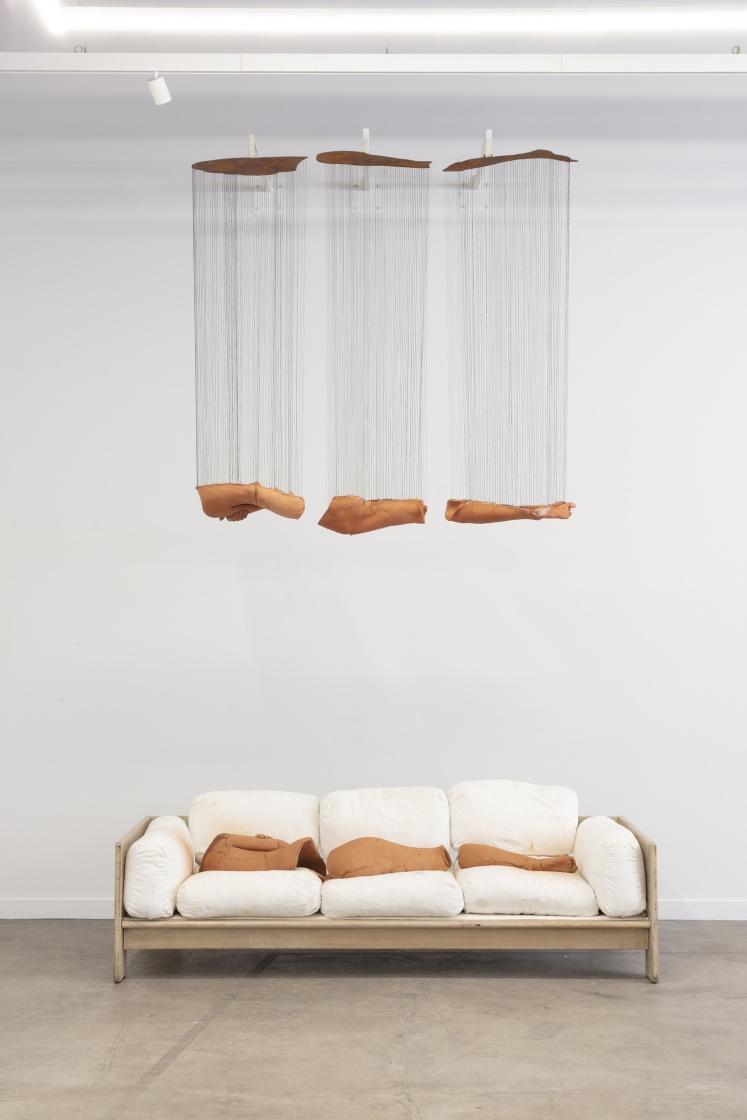
Roksana Pirouzmand, The Past Seeps Through The Present, 2022. Fired and unfired clay, water, couch, thread, metal. Dimensions variable, couch: 82 x 32½ x 21 in. Image courtesy of Murmurs.
MNH: We met at CalArts when you were 23. What were you doing in the two years before that when you got to Los Angeles?
RP: I was living with my aunt who lived here and was just getting my life together, slowly trying to be independent. I knew I was coming here to go to art school, but I had no idea what my options were. I was with my aunt for seven months, and then I got my own place. That was a very stressful time because it was the first time I was fully living by myself while also trying to keep up with making art. […] It was hard. I felt like I had lost my community of friends who were always working together. Now I was in this individual context. I was working hard to keep myself motivated and make something I was excited about. Home Depot would get me very excited. I would go to Home Depot and be like, “Wow, this place has everything!”
MNH: Home Depot is the American dream! Well, let’s talk about the family photos because they’ve returned to your work in many different ways. They were an important part of your show at Murmurs in 2022, “The Past Seeps Through the Present.” There were different aspects of your work in that show, including performance. But it was the first time I had seen that kind of work from you, which was—I hesitate to call it “two-dimensional”—a series of clay tablets with liquid beading out of the faces, almost like colored tears. Can you talk about that series and how it started?
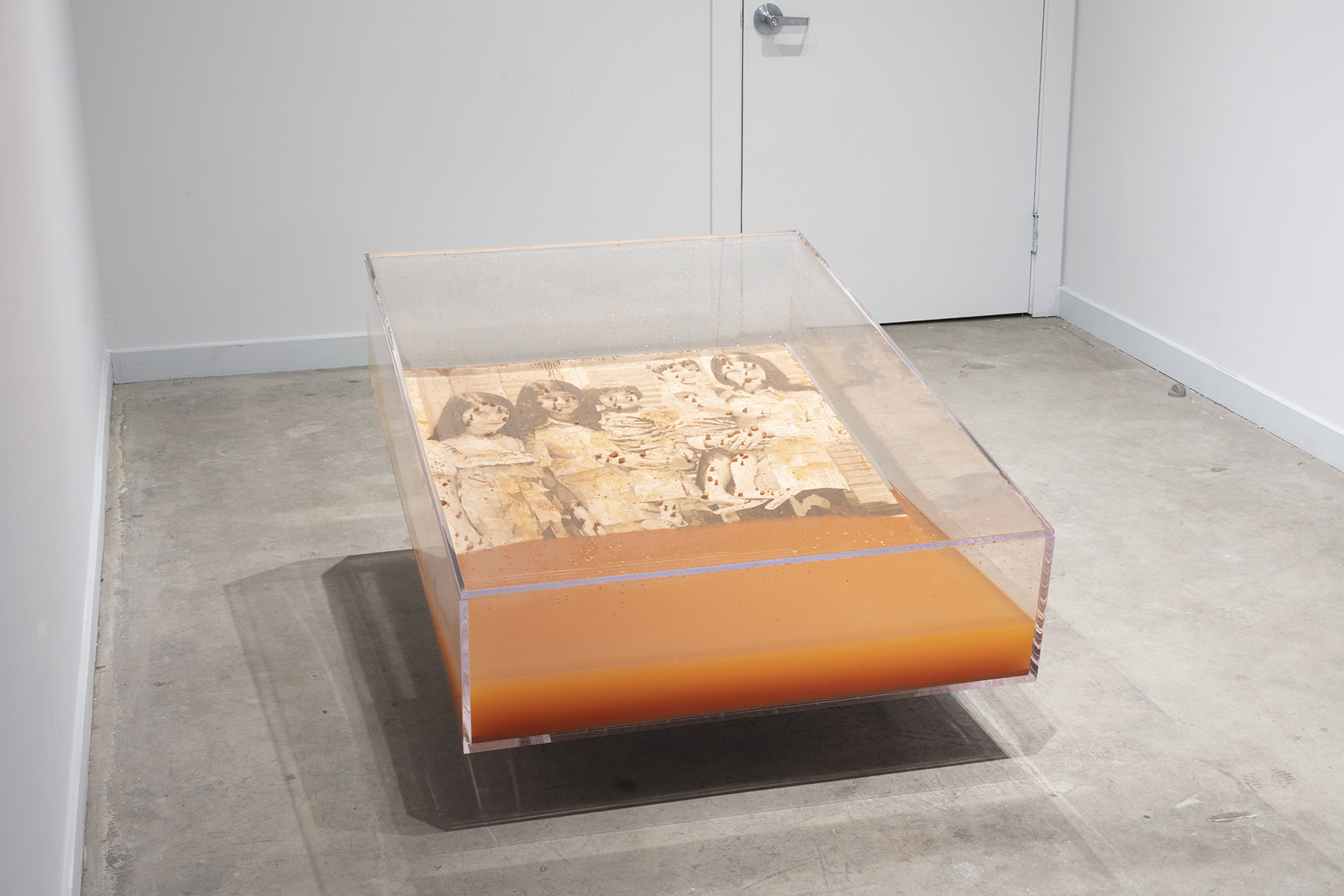
Roksana Pirouzmand, The Pasts Seeps Through the Present, 2022. Ceramic, glaze, water, clay, plexiglass, 52 x 36 x 22 inches. Image courtesy of Murmurs.
RP: I think material always brings me ideas first. I discovered this way of transferring a photo onto clay and then firing it, and then I discovered this glaze that would melt at low temperature. Combining these two would create these sweat-tears oozing out of a dry surface, so it has that watery look to it. Then I was like, how does the story come together without my knowing and does it make sense in this photo? […] Now with smart phones you have so many photos, but in the old days there were so few photos of what my grandma looked like or what the past looked like. And usually the stories I hear from my grandma are more than just what things looked like. Sometimes there are stories that you better not talk about.
MNH: Every family has those.
RP: Yeah, so those tears oozing out, that to me was this past that is present—I mean, the title of the show is “The Past Seeps Through The Present.” And I was seeing something more lively coming out of these images that are very stoic and very formal. These glazes are uncontrollable. I put them in the kiln in a vertical way, and when I open it I never know how much the glazes are going to drip, if they are going to be attracted to each other. It’s this unpredictable thing that happens in the process.
MNH: It’s like the emotional content.
RP: Exactly. I feel like those photos are personal, but they are also talking about a collective of people. I grew up Zoroastrian and it’s a small community. I don’t know, truly, how they survived. There are all these untold stories of past generations and how they were able to hold onto this culture to this day. I feel those photos and those glazed strips are a layer that represents that story. Maybe it’s not visible, but I feel like if it was shown in Iran, there are some clues in their clothing…
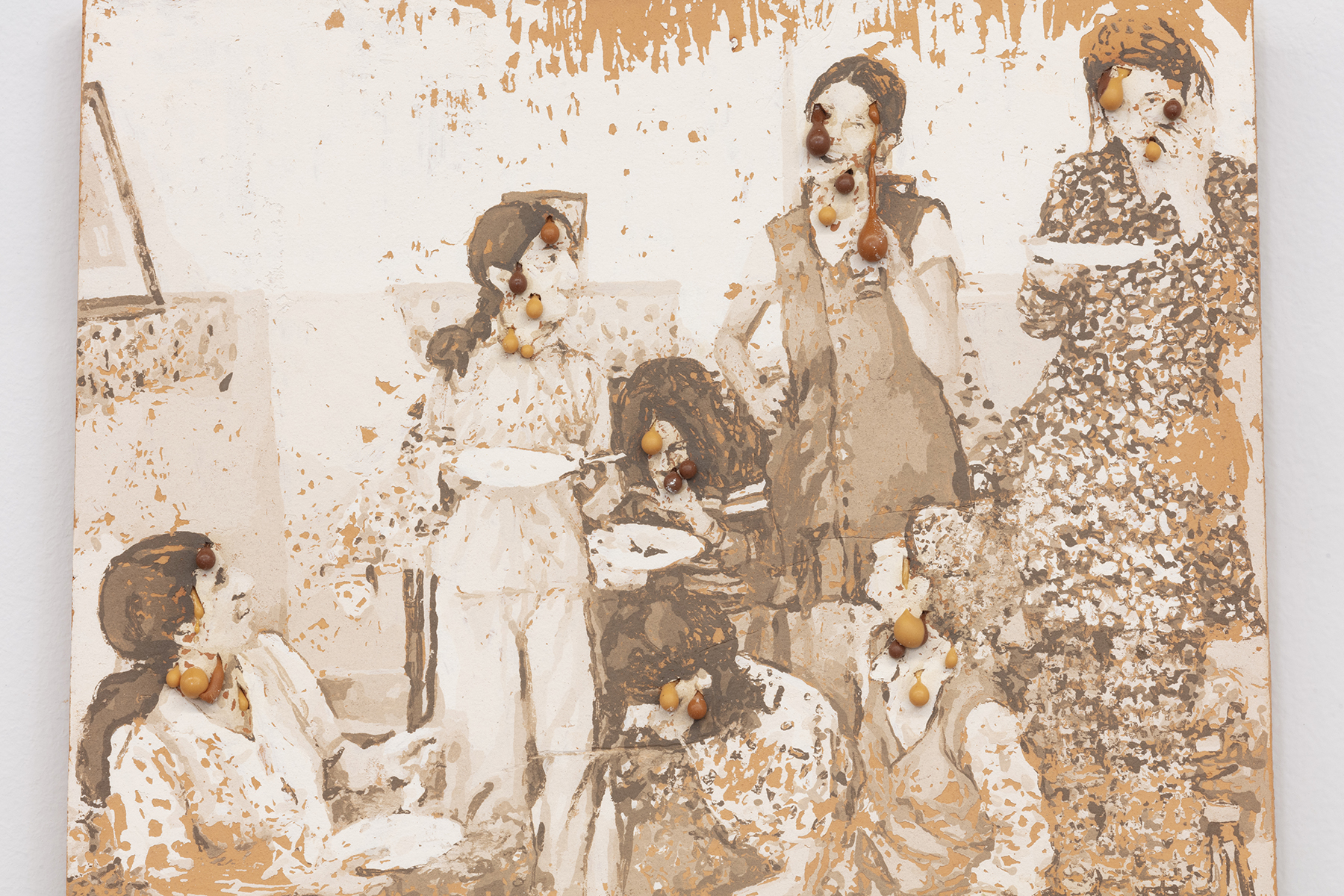
Roksana Pirouzmand, Untitled (Lunch at the Old House), 2022. Clay, glaze, 10 x 7.75 x .5 in. Image courtesy of Murmurs.
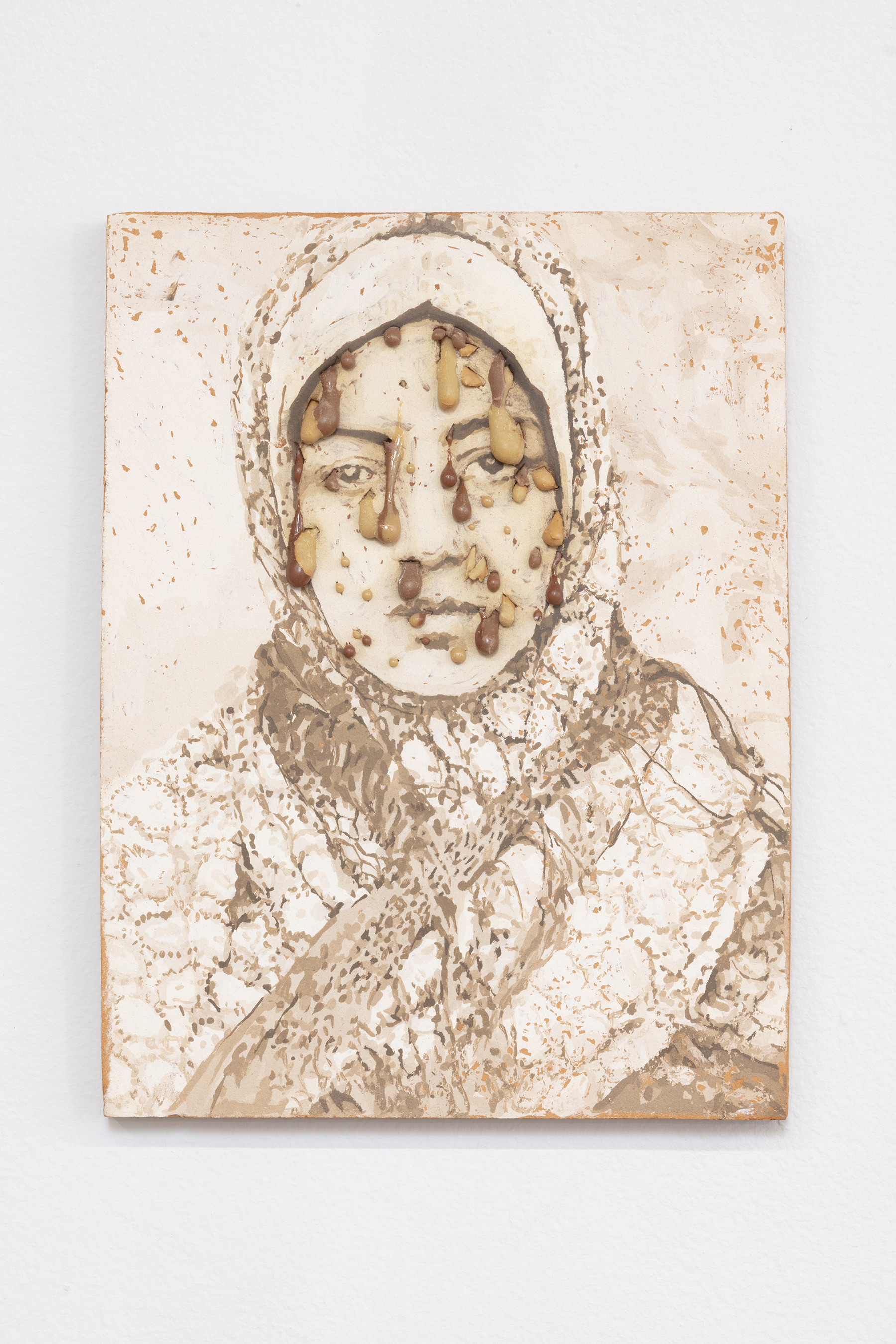
Roksana Pirouzmand, Untitled (Great Grand Aunt), 2022. Clay, glaze, 10 x 7.5 x .5 in. Image courtesy of Murmurs.
MNH: So there are those subtle Zoroastrian elements that would be read into the work that might be lost to a larger audience, but still read as an idea of the past. Is there a Zoroastrian community in Los Angeles?
RP: Yes, my aunt who lives here has so many friends. In the past 10 to 20 years, a lot of immigration of religious minorities has been happening. There’s this particular program that helps minorities get out of Iran. My grandma curses this because she’s like, “My kids are all going away because of how this program helps them to get out.” But I’m happy I had this experience in life so that I could get out of Iran.
MNH: You have a work that you’re developing for your exhibition “on my mother’s lap” for Spurs Gallery in Beijing that also includes a family photograph. It’s a fountain with the clay photograph hanging face down from strings, just overhead and will be dripping water. Can you say more about this?
RP: I guess this is a continuation of that earlier work, but the glaze drips have now become actual water. The water is going to drip over this sculpture that looks like fabric draped over bodies. The sculpture beneath is a three-dimensional version of these other paintings that I’m making, and it also looks like a landscape. It would be made out of metal and it would heat up. As the water drips on it, it will evaporate, so the matter changes, water and then steam, which disappears. That hissing sound of water dripping and evaporating on a hot object like that in a space has that element of danger, like something that you don’t want to get close to. Precarity is a thing that I think about in relation to bodies.3
MNH: I think one thing I really like about the maquette for this work is that you see two feet popping out of one side and then you see two hands coming out the other. At first it almost looks like it could be one body, but then you realize it’s at least two.
RP: I like to create that ambiguity. It’s in-between a landscape and domestic space. I still don’t know how exactly it’s going to work together, but I know it creates a feeling. Usually the process for me is that first there is an image. There are elements I imagine would sit next to each other. What it does for me and what it does for the audience comes after.
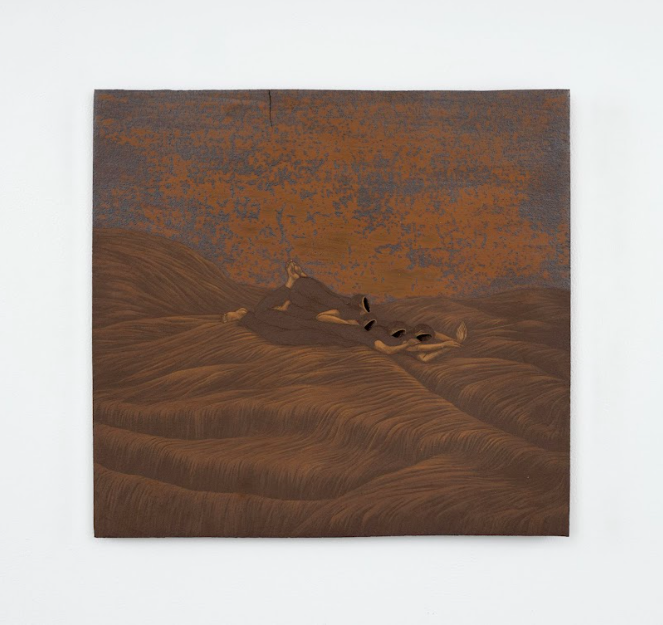
Roksana Pirouzmand, like a pebble in a riverbed, 2024. Ceramic, 18.5 x 19.75 x 0.5 inches. Image courtesy of Francois Ghebaly.
MNH: It’s so connected to other works you’ve made. But I do think for as long as I’ve known you and have seen you work, you tend to operate in a very speculative space. You do start with an image or a central idea, and you almost have to make the thing to know what it’s going to do.
RP: Yes, and that’s the excitement of it, the unknownness of it. Performance is similar: Until I perform it in front of people, I don’t know how it is going to be. I never have a clear meaning behind it.
MNH: I also think with performance, and especially in the case of the one you did at the Hammer, the performance is often for the performer first and for the audience second. And it does different things for the performer than it does for the audience. I think it’s important to acknowledge that aspect.
In “Made In L.A.” you had a fountain, too, in the courtyard of The Hammer. Titled Until All is Dissolved, it’s a work that seems to have come out of a number of different trajectories in your work. It’s a pile of five prostrating bodies cast from your body, in clay, with water coming out and running over it. Am I right that it represents generations of your family?
RP: It could be generations of family, or it could be a single body repeated in this way. I was definitely thinking about a collective. I was also thinking about care and violence and what the sculpture’s gesture actually is, while stacking up. I see it also as a performative object. If it were real people being stacked, it’s a lot of weight and pressure on the body at the bottom, so I was thinking about that as a form of surrender, that all of the bodies are in a way surrendered, praying. Or it’s a yoga gesture, whatever that gesture means to anyone […] It’s a harmless gesture, but also you can see all the cracks from the pressure, so it’s creating that duality or contrast of something safe and harmless, but also an image of something is eroding and wearing away.
MNH: My own reading of it was rather ambiguous in a similar way. I’m curious about it technically. Did you fire each body individually or all together?
RP: There were a lot of errors and tests. I did it in different ways. At the end I realized I had to fire one and then make the next cast, assemble it on top of the fired one and fire it one more time. As it goes, the bottom body has been through five firings. As they stack up, they have to change a little bit to fit into each other, so I have to transfer it while it’s still malleable. There was a lot of disappointment and stress over two months. I guess it’s the process when you have an idea and then you have to make it happen. And especially when there is a deadline, you have to keep on doing it until it works.
MNH: It was a very public deadline.
RP: Exactly.
MNH: And was it a work that you had already been thinking about before “Made In L.A.” came along?
RP: Yes, definitely. In more two-dimensional images, I was painting these figures in a similar cause-and-effect situation of one pulling the other’s hair while holding someone else at the same time. I was thinking about the relations of the body. Those paintings came out of performance ideas and what can happen in a space between bodies. It was a way for me to document ideas of performances. The sculpture was an iteration of a three-dimensional version of the paintings. I’m still thinking of the current work as a continuation of that, about body casts and how they are performing without me being in a place. […] Water also adds that motion element for me. I think water does that in a very slow and subtle way in the sculpture. Over time it’s eroding the metal underneath and bringing rust to the sculpture and circulating it.
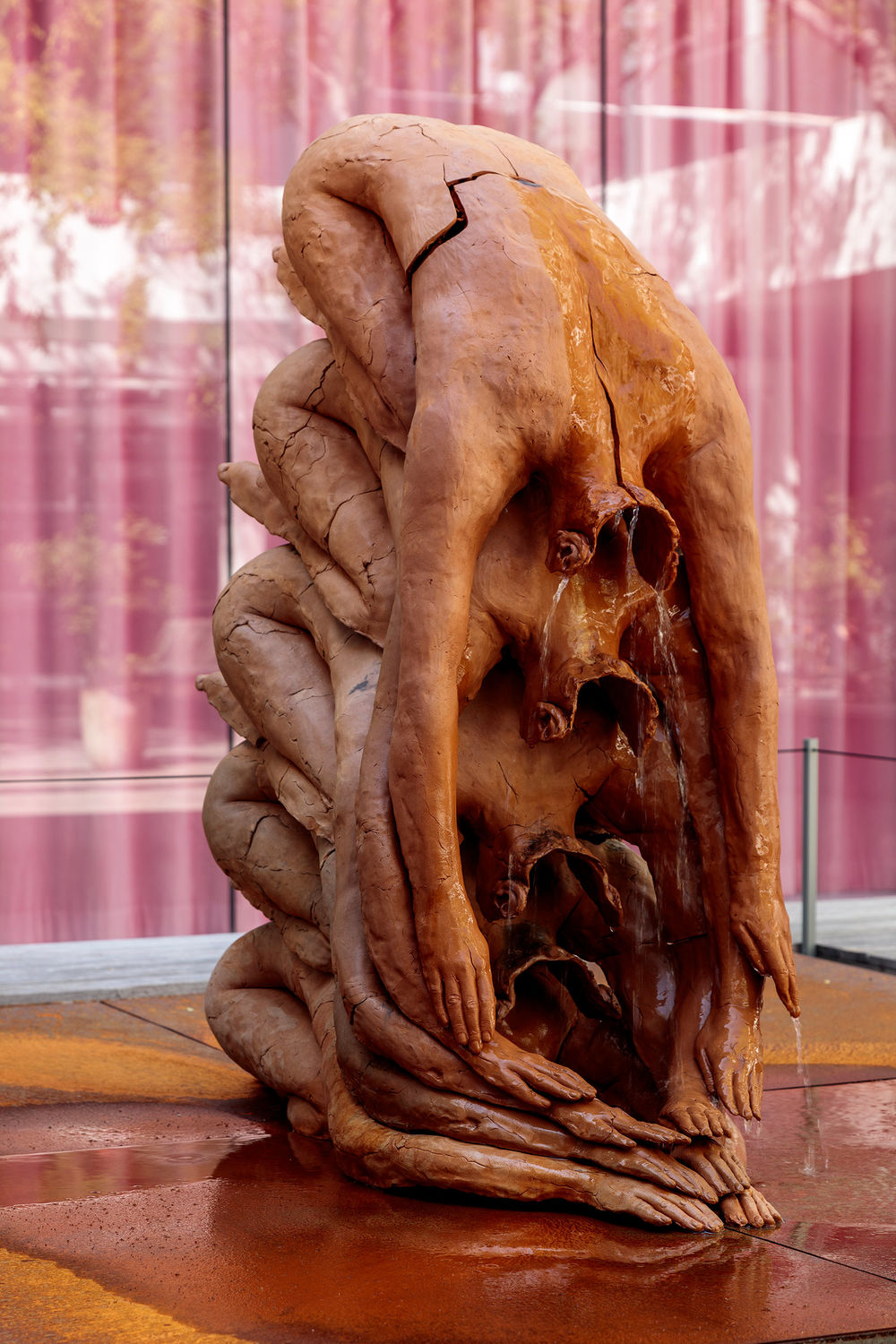
Roksana Pirouzmand, Until All Is Dissolved, 2023. Ceramic, 24 x 48 x 84 in. (61 x 121.9 x 213.4 cm) Photo: Joshua White
MNH: We started with performance, but I also want to acknowledge explicitly how important craft is to your work. You’re really good at making things.
RP: I love making.
MNH: And there’s so much material inquiry with clay in particular, but also you’ve worked with fabric and textiles, sound. When did you start working with clay?
RP: In my last year at CalArts, I took Candice Lin’s class and I was very excited about the material. What made me very excited was that you can make something out of clay and you can put it in your mouth and you can eat out of it because it’s food safe. That opened up a possibility in the material. I made a clay work called Speech-Less (2017) for my undergraduate thesis show that people could basically talk through.4I think now, after the pandemic, it might not work so well, but people were willing to participate back then.
MNH: So you started making ceramics at CalArts, and before that you had actually done more textile-based work. Your mid-residency exhibition was the dress covered with stones, which was really labor-intensive. Can you talk about that work Feel the Velvet (2015) just a little bit?5
RP: I made this dress where I sewed velvet around stones collected around campus, and then I connected all the stones together to make this really heavy 50 or 60-pound dress. I blocked the gallery space by attaching the dress to the doorway. It became an extension of the opening of the doorway. If anyone wanted to come into the exhibition, they had to wear the garment while I sewed one more stone and added it to the bottom of the dress. The performance happened for just one night, for about three hours or so.
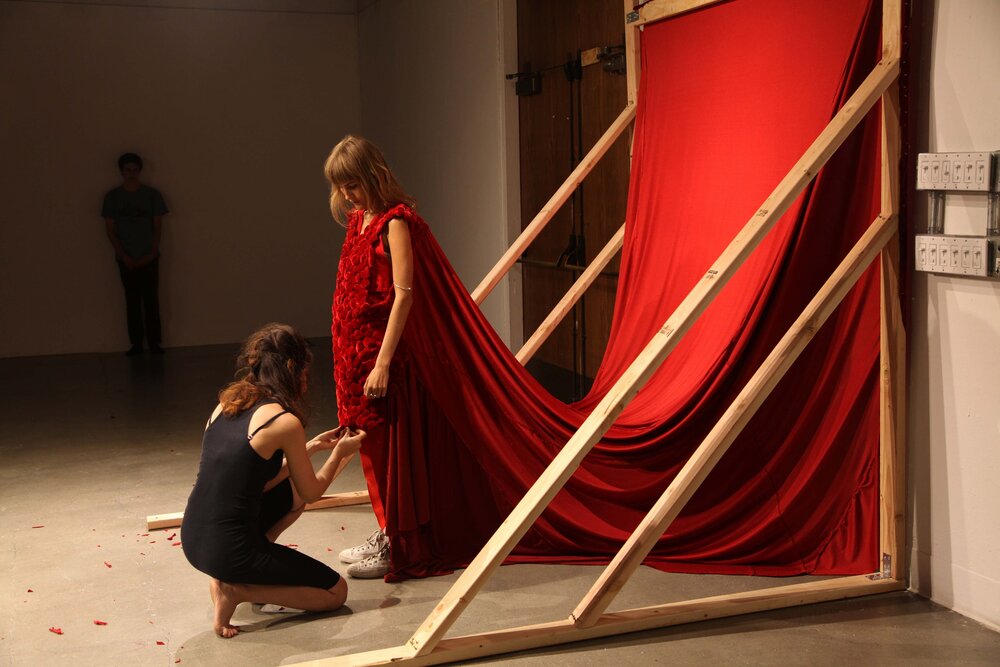
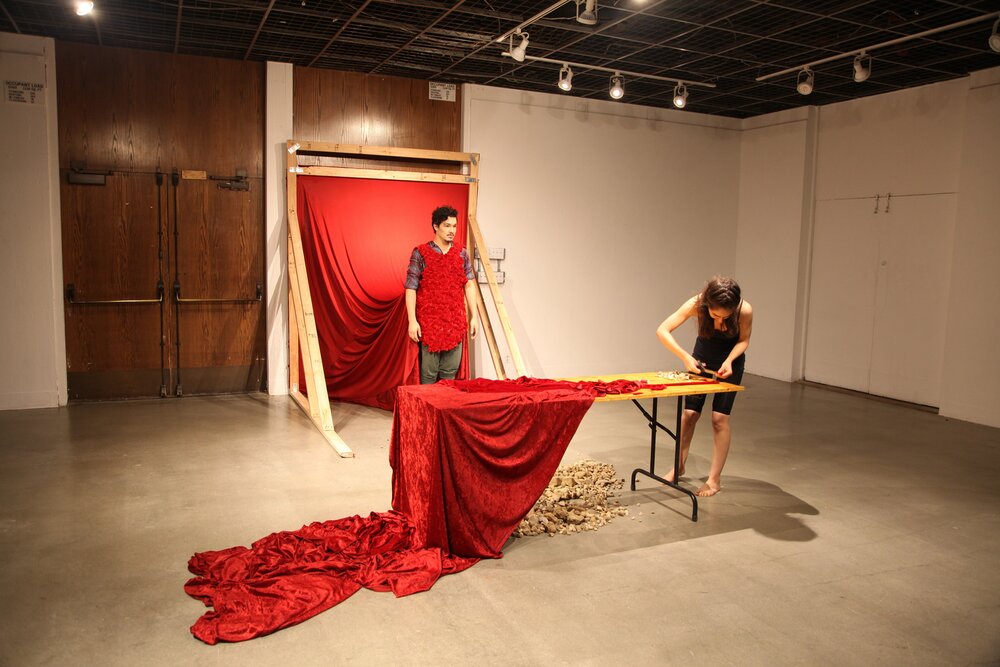
Roksana Pirouzmand, Feel the Velvet, 2015.
MNH: I remember the line got very long.
RP: That dress got pretty heavy by the end of the night. At the time, I was also thinking about labor itself and the labor of being an artist and making something to showcase that, so I put the weight on the audience, literally. I tried to switch this dynamic in a way of the artist’s audience, so they became a center point when they would wear the dress and come to the other side.
MNH: And it was a very private experience when they did so, right? It was just you, the camera person, and the person wearing the dress in the space.
RP: Yes. At the time I was not actually thinking about the presence of the camera person.
MNH: These are all the things we learn, right?
RP: Yes, exactly.
MNH: That piece, it seems so emphatically feminist to me. But it also followed another work that you had made that was also such a wild work. And I have some pictures of it. I don’t know if this one’s on your website, but it was two walls connected by a crocheted birth canal. It was very graphic.
RP: I think it was my second year when I made that one. I was really into textiles the second year.
MNH: That work seemed like it was an important gateway for you, to other things that followed.
RP: Literally.
MNH: Yes! I was also thinking about connections between you and your mother, your family, but then also the way that you create objects that become an interface between yourself and the viewer, which is something that happened more in your thesis show.
RP: That’s true. I think that work was so explicit that I was like, no, it’s too literal. It’s not my work.
MNH: I think every work you made at CalArts was an occasion and a surprise and just so memorable.
RP: Yeah. I’m glad.
MNH: You mentioned Candice Lin who was visiting faculty at CalArts, and is now at UCLA and somebody you worked with a lot there. You also worked for Candice as a studio assistant. What developed in that relationship and in your time at UCLA?
RP: To be at UCLA was a continuation of CalArts in many ways, starting with knowing Candice from CalArts.
MNH: You applied specifically in ceramics though, right? Because you have to apply to UCLA by medium.
RP: Yes, I did. That was very uncomfortable doing that, actually, because before that I didn’t know what my main medium was. It was challenging, but I knew that I was excited about ceramics and wanted to know more about it. I actually applied to the program twice, and my first application was not strong enough, saying that I wanted to learn more about ceramics. They said I should already know ceramics to come to the Master’s program, so in my second application I hid that part and was like, “I know ceramics.” […] Throughout my career, I think I’ve been so lucky by knowing the right people. Candice has been so supportive and generous in helping me throughout my MFA. Also being her assistant, I’m seeing what the other side of being an artist and showing in big galleries is like. It has been very helpful to see all of that and how she handles so many things at the same time. I’m extremely lucky having her in my life. She’s my art mom, in a way.
MNH: I’d like to talk a little bit about the paintings before we wrap up. They’re more new to me, but there were some works in your show at Grand Central Art Center that had almost a surrealist quality to them, and some of those came out of ideas for performances. But they were also clay—there is imagery on clay, and they were also sculptural. They had holes in them, or voids. So it seems to me like your newest works are also a continuation of that, but a little different too.
RP: Yes. It definitely is a continuation of that. Those images were usually a single body in a room, and the room was more defined. It was a rectangular interior for sure. In these, it becomes a group of people who are more in relation to each other directly.
MNH: They’re very entangled. It reminds me of Simone Forti’s Huddle and 1960s dance.
RP: For sure. There’s also this draping fabric that is mountainous, and the bodies that are under this mountain are interacting with the bodies that are more visible on top of it. But some bodies become ghostly because their clothing is less rendered or more camouflaged against the background, and the mountains become more rendered than the bodies. I like making these because they’re so much quicker than a sculpture. It’s more immediate.
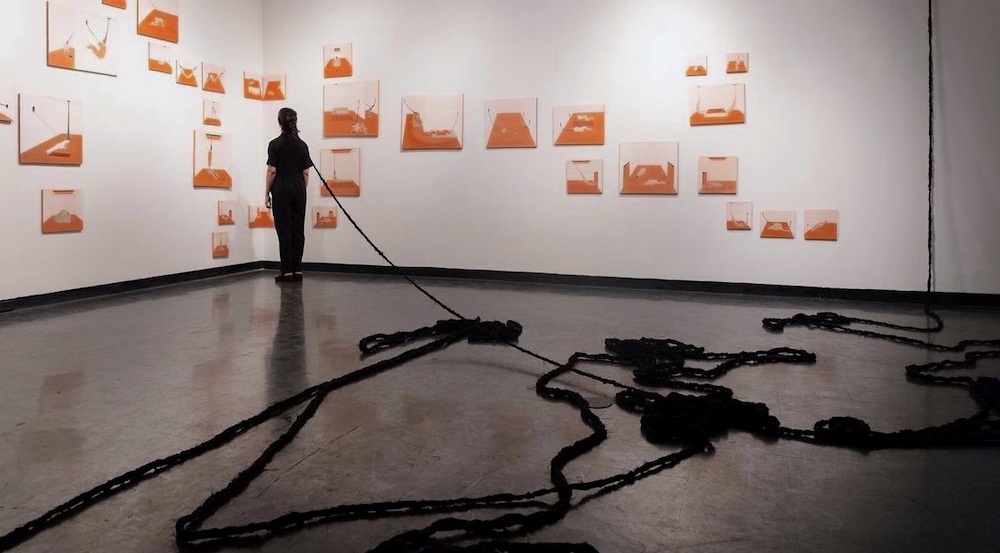
Roksana Pirouzmand, they last forever, 2021. Performance installation view, they last forever, Grand Central Art Center, Santa Ana, September 4–December 5, 2021.